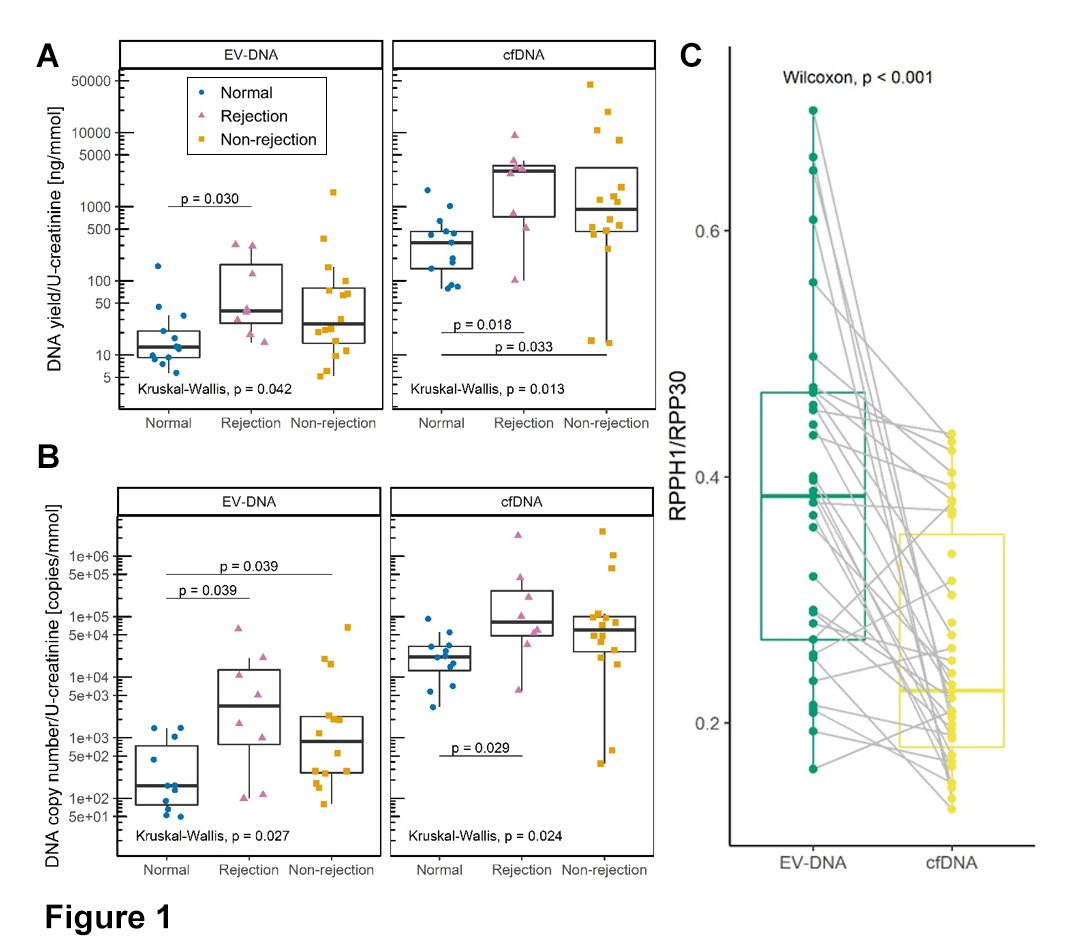Kidney Allograft Injury is Reflected in the DNA Cargo of Urinary Extracellular Vesicles
1Department of Nephrology, University Medical Centre Ljubljana, Ljubljana, Slovenia, 2Department of Biotechnology and Systems Biology, National Institute of Biology, Ljubljana, Slovenia, 3Institute of Biochemistry and Molecular Genetics, Faculty of Medicine, University of Ljubljana, Ljubljana, Slovenia, 4Institute of Pathology, Faculty of Medicine, University of Ljubljana, Ljubljana, Slovenia
Meeting: 2022 American Transplant Congress
Abstract number: 1568
Keywords: Genomic markers, Kidney, Kidney transplantation, Rejection
Topic: Basic Science » Basic Clinical Science » 17 - Biomarkers: Clinical Outcomes
Session Information
Session Name: Biomarkers: Clinical Outcomes
Session Type: Poster Abstract
Date: Tuesday, June 7, 2022
Session Time: 7:00pm-8:00pm
 Presentation Time: 7:00pm-8:00pm
Presentation Time: 7:00pm-8:00pm
Location: Hynes Halls C & D
*Purpose: Following cell injury, donor-derived cell-free DNA (ddcfDNA) is increased in the urine of kidney transplant recipients. DNA containing urinary extracellular vesicles (uEVs) are relevant biomarkers of kidney allograft injury (KAI) due to the anatomical proximity of EV producing cells and urine. Our aim was to investigate DNA as cargo of uEVs, to discover their association with KAI and to determine their biomarker potential in comparison to the urinary (dd)cfDNA.
*Methods: We collected second morning spot urine from 41 kidney transplant recipients before surveillance or for-cause biopsy. According to histological analysis, patients were divided into normal histology, rejection injury (antibody- and T-cell mediated rejection) and non-rejection injury group. We isolated uEVs, uEV-bound DNA (uEV-DNA) and urinary cfDNA. uEV characteristics (concentration and size) were determined by nanoparticle tracking analysis, while DNA parameters (yield, copy number, integrity index, donor-derived fraction) were characterized by fluorometry, donor-recipient genotyping and digital droplet PCR. DNase assay and electron microscopy immunogold labelling were used to study EV-DNA localization.
*Results: The concentration of uEVs was similar among patient groups, while the mean size was significantly smaller in the normal histology group (160.7 nm vs. 177.5 nm for rejection injury and 174.1 nm for non-rejection injury; P=0.045). Both extracted DNA entities in the rejection and non-rejection injury groups displayed higher yield (Figure 1A) and increased DNA copy numbers (Figure 1B) than uEV- and cfDNA in patients with normal histology. Notably, donor-derived uEV-DNA copy numbers were significantly elevated in patients with antibody-mediated rejection (3044.3 vs. 680.9 copies in cell-mediated rejection; P=0.036). Additionally, long/short amplicon ratio (RPPH1/RPP30) is significantly higher in uEV-DNA (green), meaning it is less fragmented than cfDNA (yellow) (Figure 1C).
*Conclusions: In conclusion, DNA is bound to the surface of uEVs and is associated with KAI, particularly allograft rejection.
To cite this abstract in AMA style:
Sedej I, Štalekar M, Žnidarič MTušek, Goričar K, Kojc N, Kogovšek P, Dolžan V, Lenassi M, Arnol M. Kidney Allograft Injury is Reflected in the DNA Cargo of Urinary Extracellular Vesicles [abstract]. Am J Transplant. 2022; 22 (suppl 3). https://atcmeetingabstracts.com/abstract/kidney-allograft-injury-is-reflected-in-the-dna-cargo-of-urinary-extracellular-vesicles/. Accessed December 13, 2025.« Back to 2022 American Transplant Congress

